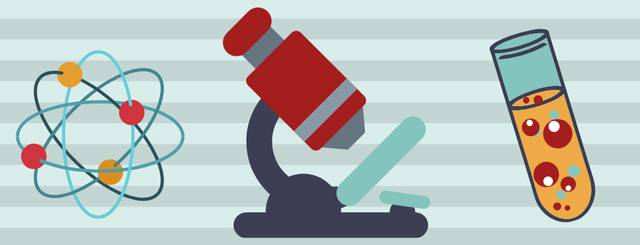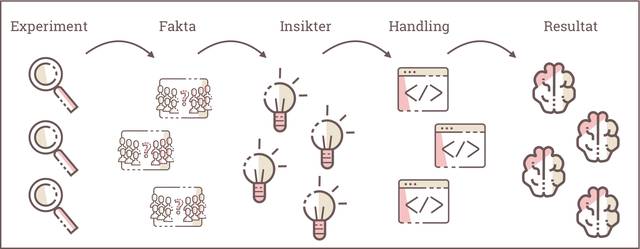
In this post, we will go through the following three points:
Atomic Research can be described as a library where all your research is collected. In the library, you break down your user data into its smallest components. It can be qualitative data, like a quote from a user interview, or quantitative data, like statistics from web analytics. From these components, you build insights. By using this data library, you can create data-driven hypotheses based on insights about your users, but more on that later.
Here are five reasons why you should start working with Atomic Research today.
1) Data-driven decisions - Ideas are sometimes communicated as insights, which can lead to an idea appearing data-driven. But by structuring all ideas and data, you can trace back to the core that the ideas are based on, i.e., actual user data.
2) Searchable fact library - Since all data is collected in one place, you can filter your research. Instead of going through your dusty PDF files one by one, you can easily retrieve data by simply pressing ctrl+F.
3) Discover patterns - It's easy to focus on just one project or data point, but with Atomic Research, you can get a holistic view. The framework includes several different data sources such as A/B tests, heatmaps, and polls. Between the different data sources, you can start to see patterns.
4) Break silos - It's easy for qualitative data to get stuck with the product team and for quantitative data to never leave the analytics team. The working method is about making data more accessible to the entire organization - open for everyone to explore so they can actually base their decisions on data.
5) Work agile - Atomic Research contributes to iterative work with continuous evaluation at every step. It is a continuous insight process meant to be shared with the rest of the organization and acted upon - not forgotten.

Everything starts with an experiment - you want to collect data about your users' behavior. In the first part of Atomic Research, you list your data collection projects. It can be usability tests, Google Analytics, surveys, or interviews with customer service, etc. We recommend focusing on collecting both qualitative and quantitative data as it provides a more nuanced picture of reality.
In experiments, your investigations are structured - you see what has been done and why. This leads to internal knowledge reuse. For example, even a new employee can know what has been done and what you are working on in the organization.
Facts are called atoms in Atomic Research. It is the data that you or someone else collects about your users' behavior. From an experiment, you can get one or more atoms. An atom can also recur in several experiments.
An atom should be neutral and free from interpretation, such as “2 out of 3 visitors on the homepage leave the site without doing anything.” Atoms are raw data, and we do not yet need to analyze why something happens, just know that it happens.
Why do we even save atoms? Because it is easy for facts to be thrown around in an organization and change over time. If you remember the game of telephone from preschool, it means that when you as a test leader/analyst compare the original fact with the fact that has gone around the organization, it has been adjusted. This is a metaphor for cumulative error, which means that the more a message is retold, the greater the chance that the message has changed from its original.
Let's continue with the previous example: “2 out of 3 visitors on the homepage leave the site without doing anything.” After the fact has spread in the organization, you hear that it has gone astray and now it is instead: “All visitors on the homepage leave the site”. Then it is good to be able to refer to the original source.
It is now time to analyze. With the help of our atoms, we build insights - our molecules. One or more atoms can be combined to create an insight.
A molecule could contain, for example, web analytics: “2 out of 3 visitors on the homepage leave the site without doing anything” and usability test “users who visit the page do not understand what product the company sells.”
In Atomic Research, triangulation of data sources becomes a standard. Read more about triangulation here. Note that an atom can even disprove a previous insight. That atom should be added to the insight to counteract your confirmation bias.
"Confirmation bias can occur if you have a pet question or perhaps designed part of the flow in the test. It means that you do not see or hear the criticism from the user, but only take in the praise. You should rather try to find errors that disprove your theory instead of confirming them. This scientific method is called 'falsification.'"
Quote from a previous blog post
Now you have gathered several insights. What do you do with them? Now it is time to take action and form organisms from the molecules. An organism is an action - something you want to do to address the insight.
In the previous example: “2 out of 3 users leave the homepage, and we see instances of behavior that they have difficulty understanding what product the company offers.” An action could be "our action will be an A/B test where we replace the product image on the homepage with an explanatory video."
In this case, only one of the insights was used, but like molecules, you can cluster several insights into an organism.
Now you are up and running - you have your structured library of atoms, molecules, and organisms. But what do you do when you have performed an action, where does the result go? Let's say the result of the previous example "our action will be an A/B test where we replace the product image on the homepage with an explanatory video" was positive. Then we have a new learning and raw data to add as an atom. This is what makes Atomic Research iterative.
In the next blog post, we will give you an insight into how we at Conversionista! work with and have optimized Atomic Research. We will provide you with an effective way to structure your data. One of the great things about Atomic Research is that you can easily integrate it into an already existing process and make it even more powerful. More on that next time!
Remember! With the help of Atomic Research, you don't have to put in blood, sweat, and tears to find your facts and insights in old PDF reports.
Happy Researching!